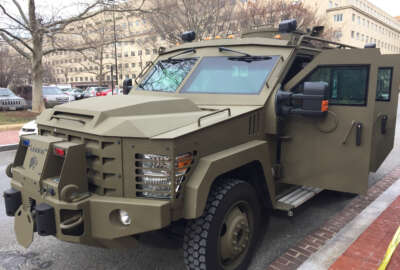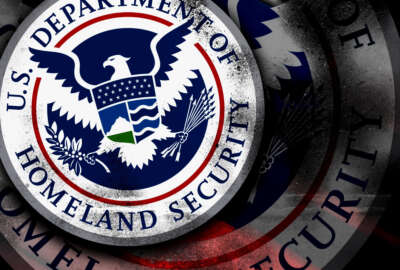
DHS Science and Technology explosive training goes to the dogs
The REDDI program offers lessons to state and local bomb detection teams.
The Homeland Security Department’s frontline defense against explosive threats also happens to be a big fan of belly rubs.
Moose, a 7-year-old yellow lab, is a member of the Fairfax County Police Department, and his job is to sniff out odors that signal bombs or other explosive devices at a place like a mall or sports arena.
On a recent day at the Capital One arena in Washington, D.C., Moose lounged at the foot of his handler Tom Eggers. The pup might as well have been on his couch at home, enjoying the day off, but in reality, the amiable canine was only resting between tests offered by the DHS Science and Technology Directorate Regional Explosives Detection Dog Initiative.
“We have our strengths, we have our weaknesses, differences in methodology from one team to the next across jurisdictional lines,” said Eggers, a master police officer and bomb dog handler. “This is a way to get people together to compare notes and find a better way to move forward with the training.”
That’s exactly the hope of S&T’s REDDI, said Don Roberts, DHS S&T detection canine program manager.
“We’re sharing knowledge and learning from them,” Roberts said. “Our overall objective is to raise the operational proficiency level of the explosive detection canine teams. Detection canines are the best, most mobile, flexible, versatile, detection tool we have in the Homeland Security arsenal. So our program is designed to provide them with tools, techniques and knowledge to have them be more proficient at what they do protecting the homeland.”
Lessons learned
So how do you teach old — and young — dogs new tricks? That’s where the subject matter experts, chemists, and other bright minds at S&T come in to create hands-on lessons for officers and their dogs.
At this particular REDDI event in Washington, dogs and their handlers from about eight different law enforcement agencies worked on odor detection and scenarios like vehicle searches and kitchen scans.
“This is what they normally do, they have to search rooms with VIPs, they have to search kitchen areas, search vehicles,” Roberts said. “These are operational search scenarios they would encounter in their daily job.”
Roberts said while S&T hopes handlers and their dogs learn a lot from REDDI, it’s also an opportunity for DHS to take home lessons of its own.
“This is knowledge sharing,” Roberts said. “We learn a lot from these state and local guys, about how they’re doing what they’re doing. We also learn what they need to make their training more effective and more efficient. These guys are busy; state and local law enforcement guys, this is not their only job handling the dogs. We need to come up with a strategy and uncover a knowledge base to make their training more efficient and as effective as it can be.”
An example of this Roberts said, is S&T’s development of a non-hazardous canine training aid.
For Eggers, the initiative offers an opportunity to get more training in, and keeps Moose on his paws. Eggers explained that like people, dogs also like to find the easy way out, so if Moose smells Eggers’ scent on an odor test, he’ll alert for a false positive because he smells his best friend.
REDDI offers tests that Eggers literally hasn’t touched, which means a true challenge for Moose.
“You definitely feel good when the dog succeeds,” Eggers said.
Copyright © 2025 Federal News Network. All rights reserved. This website is not intended for users located within the European Economic Area.
Related Stories





